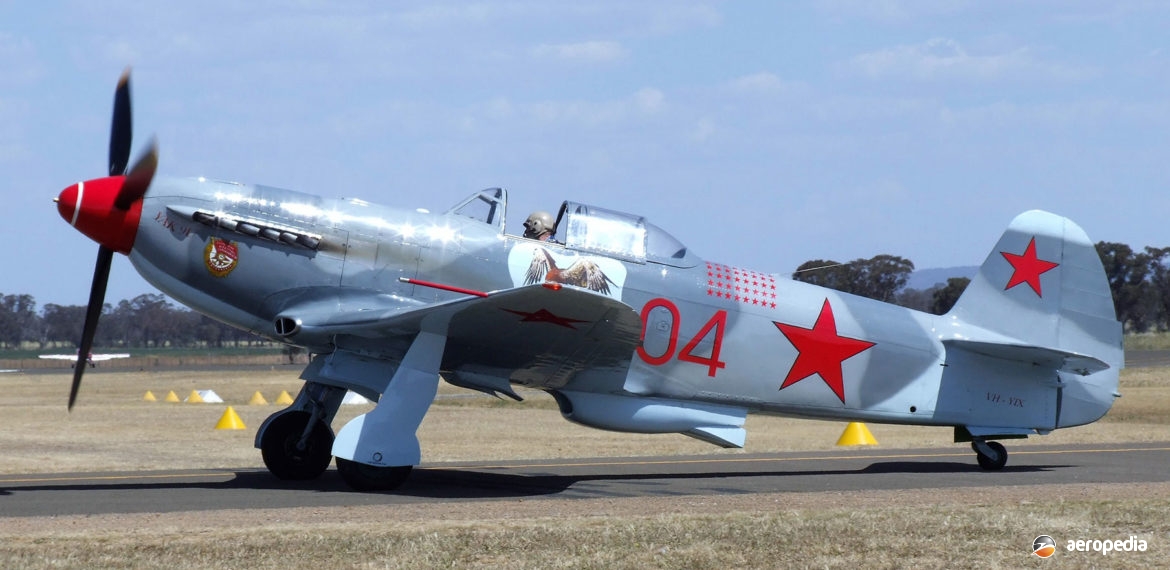Photograph:
Yak 9UM VH-YIX (c/n 0470409) at Narrandera, NSW in 2006 (David C Eyre)
Country of origin:
Union of Soviet Socialist Republics
Description:
Single-seat fighter
Power Plant:
One 903 kw (1,210 hp) Klimov M-105SPF-3 twelve-cylinder VEE liquid-cooled engine
Specifications:
- Wingspan: 9.74 m (31 ft 11½ in)
- Length: 8.55 m (28 ft 0¾ in)
- Height: 3.00 m (9 ft 10 in)
- Wing area: 17.00 m² (182.99 sq ft)
- Max speed at sea level: 535 km/h (352 mph)
- Max speed at 2,000 m (6,560 ft): 570 km/h (354 mph)
- Max speed at 6,000 m (19,685 ft): 575 km/h (375 mph)
- Ceiling: 5,000 m (16,405 ft)
- Time to 5,000 m: (16,405 ft) 5.7 mins
- Range at 300 km/h (186 mph): 1,410 km (876 miles)
- Range at 460 km/h (286 mph): 790 km (490 miles)
- Empty weight: 2,770 kg (6,107 lb)
- Loaded weight: 3,080 kg (6,790 lb)
Armament:
One engine mounted 20 mm ShVAK cannon with 120 rounds and one 12.7 mm UB machine gun with 220 rounds
History:
The Yakovlev series of fighters gained the distinction during World War II of being the workhorses on the Eastern Front and, although the initial model, the Yak 1, entered service at the beginning of the war, the series continued in service long after hostilities concluded. Variants saw service with a number of air forces, including the USSR, Poland and Yugoslavia. Later models saw action during the Korea war. The Yak series of fighters was designed by a team led by Aleksandr Sergeyevich Yakovlev.
The Yak 9 was an improvement on the Yak 7DI, first examples leaving the production line in December 1942 armed with a 20 mm cannon and a 12.7 mm (0.50 in) BS machine gun, first seeing action in the Stalingrad area. Initial model was the Yak 9, which was followed by the Yak 9M, this having an additional 12.7 mm (0.50 in) BS machine gun in the fuselage. At about the same time the Yak 9B appeared with an internal bomb-bay, with provision for 450 kg (992 lb) of bombs, entering production at State Factory No 153 in the Urals, this facility producing no less than 1,500 Yak 9Ms in the first three months of 1945.
In 1943 the Yak 9M introduced larger fuel tanks providing 650 litres (143 Imp gals) at the expense of some of the fixed armament, thus increasing range to 1,420 km (883 miles). This was followed by the Yak 9D, which had a fuel capacity of 880 litres (194 Imp gals) plus an under fuselage drop-tank, range being increased to 2,200 km (1,367 miles), this model later becoming known as the Yak 9DD.
As the need for ground-support arose because of new German armoured vehicles introduced in late 1943, the Yak 9M had its armament augmented, receiving a 37 mm NS37 cannon. However, production of this cannon could not meet production of the aircraft and some, known as the Yak 9T, were fitted with the MPSh 20 mm cannon, the 23 mm MP23 cannon, or a 12.7 mm (0.50 in) machine gun in the propeller shaft. Later the introduction of a 45 mm cannon in 1944 brought about the Yak 9K, this variant being used in anti-tank and anti-shipping roles. A third variant of the Yak 9M was introduced as the Yak 9L but did not enter production. Klimov continued development of its V-12 engines, the VK-107A having 1,194 kw (1,600 hp) compared with 940 kw (1,260 hp) in the M-105PF. The Yak-9U was the final variant, being a multi-purpose fighter.
The Yak 9 was of mixed construction, the forward fuselage structure being steel frame, the remainder wood with plywood and fabric covering in initial batches, but later models had a fuselage built up of welded steel tube. The wing structure was dural mainspars with wood ribs and plywood skinning, covered with a formaldehyde-resin polish. A total of 36,737 examples of the Yakovlev series of fighters was built.
In recent years, with a growing interest in World War II aircraft, the production jigs for a number of Russian fighter aircraft have been located and the aircraft, using modern technology, have been put back into production to meet this demand. Strela, a company in Arenberg, following conclusion of the production run of Yak 3 aircraft, commenced construction of a batch of Yak 9UMs (M for new production). The serial numbers of these aircraft following on from the serials previously used. The first (N900EA) was delivered to the United States in 1996 and this series was fitted with a 925 kw (1,240 hp) Allison V-1710 engine driving a Hamilton Standard propeller. Maximum speed was 648 km/h (402 mph) at height and at least ten have been delivered.
First example of the type in Australia arrived in late 2002 and was assembled at Archerfield, QLD, becoming VH-YXI (c/n 0917918). This aircraft was painted in the 1944 colours of an aircraft of the 5th Guards Fighter Aviation Regiment of the 295th Fighter Air Division of the VVS (Soviet Air Force).
In mid 2004 a further Yak 9UM was imported to Melbourne, VIC where it became VH-YIX (c/n 0470409), operating for some time in an undercoat scheme with a red star on the fuselage before being painted in the colours of the aircraft flown by Major Ivan Nikiforovich Stepanenko, flown on the Baltic Front in December 1944, with the emblem of The Order of the Red Banner painted on the nose.
A number of Yak 9s have been preserved in museums, one captured machine from Korea being on display at the USAF Museum in Dayton, Ohio.

